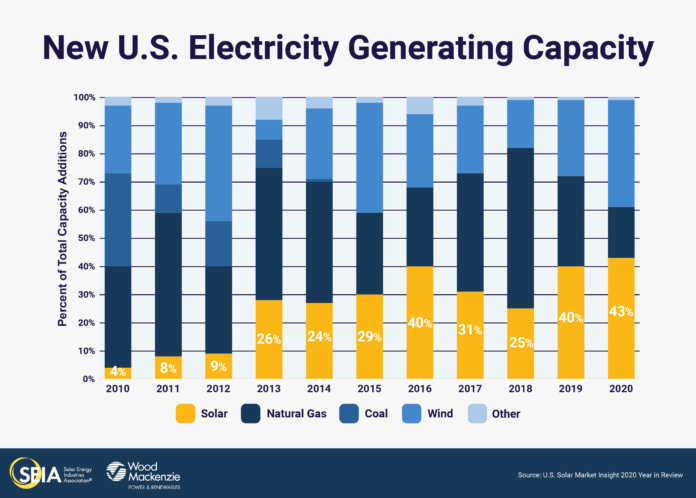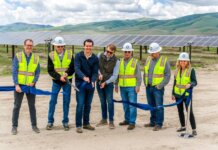The U.S. solar industry installed a record 19.2 GW DC of capacity in 2020, according to the U.S. Solar Market Insight 2020 Year-in-Review report, recently released by the Solar Energy Industries Association (SEIA) and Wood Mackenzie.
For the second year in a row, solar led all technologies in new electric-generating capacity added, representing 43% of the mix. According to Wood Mackenzie’s 10-year forecast, the U.S. solar industry will install a cumulative 324 GW DC of new capacity to reach a total of 419 GW DC over the next decade.
“After a slowdown in Q2 due to the pandemic, the solar industry innovated and came roaring back to continue its trajectory as the country’s leading source of new energy,” says Abigail Ross Hopper, president and CEO of SEIA. “The forecast shows that by 2030 the equivalent of one in eight U.S. homes will have solar but we still have a long way to go if we want to reach our goals in the Solar+ Decade. This report makes it clear that smart policies work. The action we take now will determine the pace of our growth and whether we use solar to fuel our economy and meet this climate moment.”
The 8 GW DC of new installations in Q4 2020 marks the largest quarter in U.S. solar history. For perspective, the U.S. solar market added 7.5 GW DC of new capacity in all of 2015. New capacity additions in 2020 represent an increase of more than 40% from 2019 and breaks the U.S. solar market’s previous record of 15.1 GW DC set in 2016. By 2030, Wood Mackenzie is forecasting that the total operating solar fleet will more than quadruple.
California, Texas and Florida are the top three states for annual solar capacity additions for the second straight year and Virginia joins them as a fourth state installing over 1 GW DC of solar PV. In 2020, 27 states installed over 100 MW DC of new solar capacity, a new record.
Key figures:
- Residential deployment was up 11% from 2019, reaching a record 3.1 GW. This was lower than the 18% annual growth in 2019, as residential installations were significantly impacted by the pandemic in the first half of 2020
- Non-residential installations declined 4% from 2019, with 2 GW installed. The pandemic impacted this segment through delayed project interconnections and prolonged development timelines
- There was a historic 6.3 GW DC of utility-scale projects installed in Q4 2020, bringing the annual total just shy of 14 GW DC
- A total of 5 GW DC of new utility solar power purchase agreements were announced in Q4 2020, bringing the volume of project announcements in 2020 to 30.6 GW DC and the full utility-scale contracted pipeline to 69 GW DC




